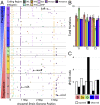Adaptive differentiation and rapid evolution of a soil bacterium along a climate gradient
- PMID: 33906949
- PMCID: PMC8106337
- DOI: 10.1073/pnas.2101254118
Adaptive differentiation and rapid evolution of a soil bacterium along a climate gradient
Abstract
Microbial community responses to environmental change are largely associated with ecological processes; however, the potential for microbes to rapidly evolve and adapt remains relatively unexplored in natural environments. To assess how ecological and evolutionary processes simultaneously alter the genetic diversity of a microbiome, we conducted two concurrent experiments in the leaf litter layer of soil over 18 mo across a climate gradient in Southern California. In the first experiment, we reciprocally transplanted microbial communities from five sites to test whether ecological shifts in ecotypes of the abundant bacterium, Curtobacterium, corresponded to past adaptive differentiation. In the transplanted communities, ecotypes converged toward that of the native communities growing on a common litter substrate. Moreover, these shifts were correlated with community-weighted mean trait values of the Curtobacterium ecotypes, indicating that some of the trait variation among ecotypes could be explained by local adaptation to climate conditions. In the second experiment, we transplanted an isogenic Curtobacterium strain and tracked genomic mutations associated with the sites across the same climate gradient. Using a combination of genomic and metagenomic approaches, we identified a variety of nonrandom, parallel mutations associated with transplantation, including mutations in genes related to nutrient acquisition, stress response, and exopolysaccharide production. Together, the field experiments demonstrate how both demographic shifts of previously adapted ecotypes and contemporary evolution can alter the diversity of a soil microbiome on the same timescale.
Keywords: Curtobacterium; adaptation; ecotypes; experimental evolution; reciprocal transplant.
Copyright © 2021 the Author(s). Published by PNAS.
Conflict of interest statement
The authors declare no competing interest.
Figures




Similar articles
-
Microdiversity of an Abundant Terrestrial Bacterium Encompasses Extensive Variation in Ecologically Relevant Traits.mBio. 2017 Nov 14;8(6):e01809-17. doi: 10.1128/mBio.01809-17. mBio. 2017. PMID: 29138307 Free PMC article.
-
Local adaptation, genetic divergence, and experimental selection in a foundation grass across the US Great Plains' climate gradient.Glob Chang Biol. 2019 Mar;25(3):850-868. doi: 10.1111/gcb.14534. Epub 2019 Jan 6. Glob Chang Biol. 2019. PMID: 30468548
-
Differential Response of Bacterial Microdiversity to Simulated Global Change.Appl Environ Microbiol. 2022 Mar 22;88(6):e0242921. doi: 10.1128/aem.02429-21. Epub 2022 Feb 2. Appl Environ Microbiol. 2022. PMID: 35108096 Free PMC article.
-
One hundred years into the study of ecotypes, new advances are being made through large-scale field experiments in perennial plant systems.Curr Opin Plant Biol. 2022 Apr;66:102152. doi: 10.1016/j.pbi.2021.102152. Epub 2022 Jan 19. Curr Opin Plant Biol. 2022. PMID: 35065527 Review.
-
Invoking adaptation to decipher the genetic legacy of past climate change.Ecology. 2018 Jul;99(7):1530-1546. doi: 10.1002/ecy.2382. Epub 2018 Jun 11. Ecology. 2018. PMID: 29729183 Review.
Cited by
-
Paradox of the Sub-Plankton: Plausible Mechanisms and Open Problems Underlying Strain-Level Diversity in Microbial Communities.Environ Microbiol. 2025 Apr;27(4):e70094. doi: 10.1111/1462-2920.70094. Environ Microbiol. 2025. PMID: 40268300 Free PMC article. Review.
-
First island-wide, single-day soil collection study on Crete reveals environmental drivers of microbial diversity.Environ Microbiome. 2025 Jul 25;20(1):94. doi: 10.1186/s40793-025-00752-z. Environ Microbiome. 2025. PMID: 40708004 Free PMC article.
-
Hyperexpansion of genetic diversity and metabolic capacity of extremophilic bacteria and archaea in ancient Andean lake sediments.Microbiome. 2024 Sep 17;12(1):176. doi: 10.1186/s40168-024-01878-x. Microbiome. 2024. PMID: 39300577 Free PMC article.
-
Latent functional diversity may accelerate microbial community responses to temperature fluctuations.Elife. 2022 Nov 29;11:e80867. doi: 10.7554/eLife.80867. Elife. 2022. PMID: 36444646 Free PMC article.
-
Bacterial population-level trade-offs between drought tolerance and resource acquisition traits impact decomposition.ISME J. 2024 Jan 8;18(1):wrae224. doi: 10.1093/ismejo/wrae224. ISME J. 2024. PMID: 39495619 Free PMC article.
References
-
- Tenaillon O., et al. ., The molecular diversity of adaptive convergence. Science 335, 457–461 (2012). - PubMed
-
- Koskella B., Vos M., Adaptation in natural microbial populations. Annu. Rev. Ecol. Evol. Syst. 46, 503–522 (2015).
Publication types
MeSH terms
Substances
Supplementary concepts
LinkOut - more resources
Full Text Sources
Medical
Miscellaneous

